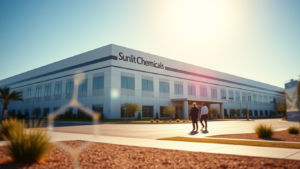Tucson’s economy continues to gain momentum with faster growth predicted for the next two years.
That was one of the key takeaways from Friday’s University of Arizona Eller College of Management annual Economic Outlook Luncheon at the Westin La Paloma Resort in Tucson.
More than 500 people packed the room to hear presenters George W. Hammond, director and research professor at Eller’s Economic and Business Research Center, and Anthony Chan, Chase chief economist, share their predictions regarding job growth, the housing sector, the stock market, interest rates and more.
Hammond shared that Arizona’s economy continues to grow, with the Tucson metro area finally gathering momentum. In particular, Tucson’s job growth began to accelerate this year and looks set to carry faster growth into 2017 and 2018.
The forecast calls for Tucson’s job growth to rise from 0.6 percent in 2015, to 1.4 percent this year, then to the 2.0 percent range in 2017 and 2018.
“Those growth rates translate into 5,300 net new jobs this year, 7,100 in 2017, and 7,600 in 2018,” Hammond said.
Most new jobs during the next three years are expected to be in education and health services; leisure and hospitality; professional and business services; and trade, transportation, and utilities.
Hammond said manufacturing jobs are expected to increase, reflecting the announcement of new jobs coming at Raytheon and Vector Space Systems. The forecast calls for modest job losses in natural resources and mining, reflecting low copper prices.
“If Tucson’s job growth hits the forecast in 2016, that would be the fastest pace since 2012. The forecast growth rates in 2017 and 2018 would be the fastest pace since 2006, before the Great Recession began,” he said.
According to employment estimates from Eller’s Economic and Business Research Center, Tucson added 2,700 jobs in the third quarter of 2016, compared to a year earlier. That translated into 0.8 percent growth, which was a bit slower than growth in the first and second quarters.”
Sectors adding the most jobs in the third quarter were education and health services; manufacturing; government; and trade, transportation and utilities. Employment increases in manufacturing in part reflected growth in the aerospace sector.
Natural resources and mining posted the largest job losses over the year in the third quarter, reflecting persistently low copper prices.
“It looks to be a better year for job growth,” Hammond said. “Tucson’s over-the-year job growth through the first 10 months of the year accelerated to 0.9 percent in 2016, from just 0.5 percent in 2015.”
Hammond also shared data relating to Tucson’s housing market. According to data from the Federal Housing Finance Administration, Tucson’s house prices increased by 5.9 percent over the year in the second quarter of 2016, slightly faster than the national rate of 5.4 percent. Tucson’s house prices are still 23.4 percent below their pre-recession peak.
“Tucson’s housing permit activity started 2016 strong, but has softened considerably during the second half of the year. Permits are expected to finish the year modestly above 2015, reflecting positive but slow population growth,” Hammond said.
One major shift during the past two years has been a major appreciation in the value of the U.S. dollar versus most currencies, but especially against the Mexican peso. As of October 2016, the U.S. dollar bought 18.89 pesos, up 45.4 percent since mid-2014. During the past few weeks, it has risen even further, to just over 20 pesos per dollar, an all-time high.
“The strong dollar is putting downward pressure on Arizona’s merchandise exports to Mexico, which have declined 10.5 percent so far this year, compared to 2015. The dollar is also likely adversely affecting Mexican visitor spending in the state,” Hammond said.
Anthony Chan spoke to the audience about the global economy and financial markets, stating that the U.S. economic and equity market outlook will remain bullish for 2017.
“We expect a U.S. real GDP growth of 2.0 percent in 2017 compared to growth of about 1.6 percent in 2016,” Chan said. “Growth will be fueled by lower U.S. personal and corporate tax rates, increased infrastructure spending and a business-friendly 70 percent reduction in federal government regulations promised by President-Elect Trump.”
With inflation increasing, The Federal Reserve is also preparing to gradually raise short-term rates starting at its mid-December policy meeting this week.
“This should dampen price pressure further without unduly raising the risk of killing the current economic expansion,” Chan said.
Hammond closed his presentation on a positive note, stating that Tucson looks to be headed toward stronger economic performance in coming years.




